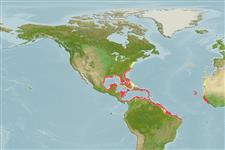Teleostei (teleosts) >
Anguilliformes (Eels and morays) >
Muraenidae (Moray eels) > Muraeninae
Etymology: Gymnothorax: Greek, gymnos = naked + Greek, thorax, -akos = breast (Ref. 45335).
Environment: milieu / climate zone / depth range / distribution range
Ecology
Marine; reef-associated; depth range 1 - 50 m (Ref. 58047), usually 5 - 30 m (Ref. 26938). Tropical; 42°N - 30°S, 99°W - 13°W (Ref. 55256)
Western Atlantic: New Jersey (USA), Bermuda, and northern Gulf of Mexico to Brazil. Recorded once from Nova Scotia, Canada. Eastern Atlantic and eastern Pacific (Ref. 26340).
Size / Weight / Age
Maturity: Lm ? range ? - ? cm
Max length : 250 cm TL male/unsexed; (Ref. 7251); common length : 150 cm TL male/unsexed; (Ref. 5217); max. published weight: 29.0 kg (Ref. 9710)
Very large brown moray, uniformly dark green to brown (Ref. 26938).
A benthic and solitary species (Ref. 26340) occurring along rocky shorelines, reefs, and mangroves (Ref. 3255).Usually found shallower than 30 m (Ref. 26938). Due to its large size and aggressiveness, the bites of this moray are particularly dangerous (Ref. 3255). Feeds mainly at night on fish and crustaceans (Ref. 42064). Marketed fresh and salted (Ref. 3255). Large individuals are ciguatoxic (Ref. 3255).
Life cycle and mating behavior
Maturities | Reproduction | Spawnings | Egg(s) | Fecundities | Larvae
Spawning migrations and leptocephalus larvae (ref. 42064).
Robins, C.R. and G.C. Ray, 1986. A field guide to Atlantic coast fishes of North America. Houghton Mifflin Company, Boston, U.S.A. 354 p. (Ref. 7251)
IUCN Red List Status (Ref. 130435)
Threat to humans
Traumatogenic (Ref. 3255)
Human uses
Fisheries: minor commercial; aquarium: public aquariums
Tools
Special reports
Download XML
Internet sources
Estimates based on models
Preferred temperature (Ref.
123201): 23.3 - 28, mean 26 °C (based on 476 cells).
Phylogenetic diversity index (Ref.
82804): PD
50 = 0.5000 [Uniqueness, from 0.5 = low to 2.0 = high].
Bayesian length-weight: a=0.00062 (0.00041 - 0.00093), b=3.27 (3.15 - 3.39), in cm total length, based on LWR estimates for this species & Genus-body shape (Ref.
93245).
Trophic level (Ref.
69278): 4.0 ±0.71 se; based on food items.
Resilience (Ref.
120179): Very Low, minimum population doubling time more than 14 years (Preliminary K or Fecundity.).
Fishing Vulnerability (Ref.
59153): Very high vulnerability (90 of 100).
Nutrients (Ref.
124155): Calcium = 16 [8, 25] mg/100g; Iron = 0.4 [0.2, 0.8] mg/100g; Protein = 18.7 [16.4, 21.3] %; Omega3 = 0.0823 [, ] g/100g; Selenium = 60.6 [27.2, 130.1] μg/100g; VitaminA = 56.2 [13.7, 218.4] μg/100g; Zinc = 0.72 [0.49, 1.05] mg/100g (wet weight);
